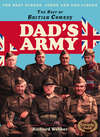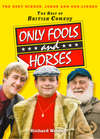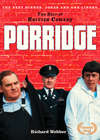Kitabı oxu: «The Complete A–Z of Everything Carry On»


COPYRIGHT
HarperCollinsPublishers Ltd.
1 London Bridge Street
London SE1 9GF
First published by HarperCollinsEntertainment 2005
Copyright © Richard Webber 2005
The Carry On films are protected under copyright
1959 to 1965 films are distributed by Canal Plus Images UK Ltd
1966 to 1978 films are distributed by Granada Ventures Ltd
A catalogue record for this book is available from the British Library
Richard Webber asserts the moral right to be identified as the author of this work
HarperCollinsPublishers would like to thanks the following for providing photographs and for permission to reproduce copyright material:
Page 19, © Keith Turley; 155, © J.C. Eyer; 156, © Maidenhead Advertiser; 210–211, © Estate of Geoffrey and Nora Rodway.
All other Carry On film images are reproduced with the kind permission of ITV © Canal Plus (1959–1965 films) and © Granada Ventures (1966–1978 films).
Whilst every effort has been made to trace the owners of copyright material reproduced herein, the publisher would like to apologise for any omissions and will be pleased to incorporate missing acknowledgements in any future editions.
All rights reserved under International and Pan-American Copyright Conventions. By payment of the required fees, you have been granted the nonexclusive, non-transferable right to access and read the text of this ebook on screen. No part of this text may be reproduced, transmitted, downloaded, decompiled, reverse engineered, or stored in or introduced into any information storage retrieval system, in any form or by any means, whether electronic or mechanical, now known or hereinafter invented, without the express written permission of HarperCollins ebooks
HarperCollinsPublishers has made every reasonable effort to ensure that any picture content and written content in this ebook has been included or removed in accordance with the contractual and technological constraints in operation at the time of publication
Source ISBN: 9780007182237
Ebook Edition © MAY 2017 ISBN: 9780008188962
Version: 2017-06-01
DEDICATION
To Ian, Andy and Anna, thanks for all your help.
CONTENTS
Cover
Title Page
Copyright
Dedication
Carry On Chronology
Introduction
About the Book
Step-by-Step History of the Carry On Films
A-Z
A
B
C
D
E
F
G
H
I
J
K
L
M
N
O
P
Q
R
S
T
U
V
W
XYZ
Carry On Revisited
Books
Merchandise
DVD Releases
Video Releases
Selected Scripts
Carry On Sergeant by John Antrobus
Carry On Escaping by Talbot Rothwell
Keep Reading
Bibliography
Acknowledgements
About the Author
Also By
About the Publisher
THE CARRY ON CHRONOLOGY
| FILMS | |
| Sergeant | (1958) |
| Nurse | (1959) |
| Teacher | (1959) |
| Constable | (1960) |
| Regardless | (1961) |
| Cruising | (1962) |
| Cabby | (1963) |
| Jack | (1963) |
| Spying | (1964) |
| Cleo | (1964) |
| Cowboy | (1965) |
| Screaming! | (1966) |
| Don’t Lose Your Head | (1966) |
| Follow That Camel | (1967) |
| Doctor | (1968) |
| Up The Khyber | (1968) |
| Camping | (1969) |
| Again Doctor | (1969) |
| Up the Jungle | (1970) |
| Loving | (1970) |
| Henry | (1971) |
| At Your Convenience | (1971) |
| Matron | (1972) |
| Abroad | (1972) |
| Girls | (1973) |
| Dick | (1974) |
| Behind | (1975) |
| England | (1976) |
| That’s Carry On | (1977) |
| Emmannuelle | (1978) |
| Columbus | (1992) |
| London (still in production at time of compiling this chapter) |
| STAGE | |
| London! | (1973–75) |
| Laughing – with The Slimming Factory | (1976) |
| Wot A Carry On in Blackpool | (1992) |
| TELEVISION | |
| Christmas | (1969) |
| Again Christmas | (1970) |
| Christmas | (1972) |
| What A Carry On! | (1973) |
| Christmas | (1973) |
| CARRY ON LAUGHING series … | |
| The Prisoner of Spenda | (1975) |
| The Baron Outlook | (1975) |
| The Sobbing Cavalier | (1975) |
| Orgy and Bess | (1975) |
| One in the Eye for Harold | (1975) |
| The Nine Old Cobblers | (1975) |
| The Case of the Screaming Winkles | (1975) |
| The Case of the Coughing Parrot | (1975) |
| Under the Round Table | (1975) |
| Short Knight, Long Daze | (1975) |
| And In My Lady’s Chamber | (1975) |
| Who Needs Kitchener? | (1975) |
| Lamp-posts of the Empire | (1975) |
| Carry On Laughing’s Christmas Classics | (1983) |
INTRODUCTION
Values and attitudes are not immutable, particularly as the years slip by and society evolves, yet people’s views on the Carry On films remain seemingly constant through the generations. The unrestrainable Carry On franchise marches on, unaffected by changing fashions in an increasingly cynical world. Unashamed of its blatantly simplistic formula and unmoved in an atmosphere increasingly blinded by the political correctness brigade, the winning amalgam of sight gags, ludicrous plots, exaggerated characterisations and increasingly innuendo-laden scripts has entertained millions for nigh on fifty years. While other offerings from the comedy genre have become embarrassingly outdated, the antics of Sid James, Kenneth Williams, Charles Hawtrey, Hattie Jacques, Joan Sims et al. remain fresh, accessible and have now attracted cult status.
The Carry Ons were a lean slice of British comedy: there was no fat, no unessential baggage in the scripts, performances or direction; they were never going to win an Oscar but, to be honest, no one intended them to. Each tightly packaged product didn’t need to aspire to such dramatic heights because they were worth their weight in gold for what they set out to be: simple, fun and sure to pack the auditoriums around the country. They are not to everyone’s liking, of course; there are those who regard the Carry Ons as smutty and sexist, but the vast majority of the viewing public looked forward to the next instalment in the film series. Medical romps were always popular, as were historical capers, but one of the essential ingredients in the success of the movies was their predictability: audiences loved knowing they’d see their favourite actor playing the same old role, such as Hattie Jacques as an imperious matron. The films evolved but retained their charm, although later entries – England, Emmannuelle and Columbus – were pallid versions of their predecessors, lacking many of the trademarks epitomising a true Carry On.
Original writer Norman Hudis was able to interweave hilarious situations with moments of pathos. Take the tearjerking final scenes in Sergeant, when the hard taskmaster, Sergeant Grimshaw, upon retiring from the army after seeing his final intake march away as a champion platoon, is presented with a cigarette lighter by the lads. Personally, I missed these moments of gravitas once Hudis headed to the States and was replaced by Mister Double Entendre himself, Talbot Rothwell, heralding a new era in the history of the Carry Ons and a difference in the approach. The comedy became more cheeky but was embraced with a warmth unrivalled by any series of comedy films produced. The saucy seaside-postcard humour appealed to the British masses and each production displayed an indefinable charm; nowadays, attempts to recreate the magic and atmosphere which surrounded the films would never succeed.
Despite the many other pictures Rogers and Thomas brought to the silver screen, it’s the Carry On films with which they’re most associated. When an unwanted script about the love of two ballet dancers, entitled The Bull Boys, landed on Rogers’ desk in the mid-1950s, the success story began. The basic premise of national service was adopted and Norman Hudis employed to write a screenplay entitled Carry On Sergeant. Costing £74,000 to produce, it became one of the top box-office successes of 1958, and was quickly followed by Nurse, the highest-earning film in Britain during 1959; it also gained plaudits in America, where it played at cinemas for over two years. The success story had well and truly begun.
Richard Webber
Minehead – September 2005
ABOUT THE BOOK
Writing this book has been an exhausting, time-consuming, painstaking yet enjoyable task. The trouble is, when you set out to pen an A-Z of any series of television programmes or films, it’s difficult to know when to take your fingers off the keyboard, switch off at the mains and declare the manuscript complete. Inevitably there’s always more you could write, extra detail you could include, points that could be explored from a different angle; but before you know it, a manageable task – although, at times, it can appear completely unmanageable – quickly turns into an uncontrollable monster.
Compiling an A-Z is beset with headaches. As well as the aforementioned points, one always has that nagging thought in the back of one’s mind that such a book has to try and include references to every minute scrap of detail concerning the subject matter – in this case, the Carry Ons – but to be honest, it’s not feasible. Usually time constraints provide the final discipline, and if it’s not time you’re short of, it’s the overall word count allowed by the publisher which restricts you. So, as you can see, it’s not been easy deciding what qualifies for inclusion in this A-Z of Carry On.
One of the most challenging tasks has been tracking down some of the actors, actresses and crew members associated with the films, many of whom have long since left the profession or are now treading the boards of that great theatre in the sky. With agents, Equity or Spotlight holding no contact details, it’s been virtually impossible, in some cases, to unearth relevant information about some of the actors’ lives to enable me to pen a profile in the book. Occasionally I’ve resorted to telephone directories and cold-calling in the hope of tracing some of the profession’s more elusive people. I have, therefore, included as many profiles as possible, thereby helping fans know at least a little more about the people associated with the films. If I was working to an open-ended contract in terms of delivery date for the manuscript perhaps I could take the next ten years or so and, no doubt, locate more performers, but, alas, that’s not feasible.
Although I’ve included details of the various stage productions and television episodes over the years, I’ve decided to focus primarily on the films that had people guffawing – albeit to varying degrees – in cinemas around the British Isles upon their release. Although the small-screen offerings and highly successful stage shows were authorised projects and provided welcome entertainment for fans, it’s the films which I regard as the stars of the Carry On canon. In the main body of the text, I’ve concentrated on the first thirty films, from Sergeant to Emmannuelle, with Columbus and London featuring in the ‘Carry On Revisited’ chapter.
As mentioned earlier, I’ve tried to make this tome as comprehensive as I could, cramming in as much information as possible, but there are bound to be some details or areas that haven’t made their way into the book. Nonetheless, I hope you find what is included informative, entertaining and helpful in answering all those nagging questions you have about the Carry On films. As well as actor and crew profiles, there are character profiles too. Even those unseen characters mentioned in the scripts have been given their rightful place in this publication, together with details of who mentioned them, in what film and the context in which their names were used.
And then there are the ‘What Might Have Been’ scenes. The majority, if not all, Carry On fans won’t have seen the scenes included under this heading. Most were probably cut before the film hit the cinemas, while others could have been lost when the big-screen version was adapted either for the small screen or video format. Then there are situations when a minor character perhaps had a little more to say before the editor’s knife was sharpened, resulting in the said character’s utterance extending to little more than a couple of lines. Whatever the circumstances, these selections makes interesting reading, such as the anaesthetist’s scene involving John Horsley and Terence Longdon in Nurse.
Carry On reading – oh, and enjoy it too.
STEP-BY-STEP HISTORY OF THE CARRY ON FILMS
1955
In August, Sydney Box commissioned R.F. Delderfield to write a film outline with the working title, National Service Story. The treatment was delivered but the project was abandoned in September.
1956
The Rogers and Thomas film partnership, as producer and director respectively, began in earnest with the release of Circus Friends for the Children’s Film Foundation.
1957
The National Service story was revisited and, in January, Sydney Box again commissioned Delderfield to prepare a screenplay, later titled The Bull Boys. When Box was unable to interest a financial backer, Rogers took the basic premise of conscription and decided to develop a comedy.
He approached Associated London Scripts for a scriptwriter to pen the screenplay. Spike Milligan and Eric Sykes turned down the chance but, in September, fellow writer John Antrobus was commissioned to complete a script for £750. Unfortunately the script didn’t meet with Rogers’ approval and he asked Norman Hudis, a contract scriptwriter, to pen a comedy screenplay based on national service for a fee of £1000. Hudis delivered a script blending comedy with pathos, a rich example of the style that had become one of Hudis’ most coveted trademarks.
1958
Permission was granted by the War Office for the film to be shot at the Queen’s Barracks, Guildford. Filming started on 24 March, initially with interior shots at Pinewood, and continued until May. The final production cost of making the film was under £78,000. By this time, Norman Hudis was already working on the next script, Nurse, delivering the first draft in June. Filming began on 3 November and was scheduled until 12 December. But even before the film was released, Peter Rogers was thinking ahead to Teacher, Constable and Regardless; for the first time, it was clear the foundations for an on-going series were being put in place. The final cost of making Nurse was £82,500, but before the year was out, scriptwriter Norman Hudis had already delivered the first draft of his screenplay for Teacher.
1959
Nurse was released in March and, like Sergeant, became a box-office hit in the UK: it also sold well abroad, particularly America. By March, the next production, Teacher, was already under way. Joan Sims, Hattie Jacques, Kenneth Williams, Kenneth Connor, Charles Hawtrey and Leslie Phillips were back, and now the basis of a Rogers-and-Thomas’ repertory company was forming.
A welcome introduction to the cast was Ted Ray, playing Mr Wakefield, the stand-in head at Maudlin Street School. Sadly, it was to be his one and only Carry On, much to Peter Rogers’ disappointment. With the children, including Richard O’Sullivan, recruited from London’s Corona Academy, location shooting took place at the Drayton Secondary School, Drayton Gardens, West Ealing, and was completed by 10 April. Filming, however, had begun back on 9 March at Pinewood with internal shots in Wakefield’s study.
The film was released in August, just as Hudis put the finishing touches to the first draft of his Constable script, which was based on an idea by Brock Williams. Filming began on the streets of Ealing on 9 November.
While the film saw Leslie Phillips make his last appearance in a Carry On until, thirty-three years later, he reappeared in Columbus, Sid James made his debut. He became the anchor for many of the future films, a pivotal point around which storylines revolved. Filming at Pinewood was completed by mid-December.
1960/61
Constable was released in February and Hudis began work on Regardless, which he’d later class as his least favourite script. A seven-week filming schedule ran from 28 November until 17 January 1961, with the film’s release in March. Peter Rogers registered the title, Carry On Cruising, subsequently to become the sixth in the series, with the British Film Producers’ Association in March 1961, by which time he’d already received a story treatment, initially entitled Carry On At Sea, from Eric Barker. The treatment was delivered by the summer of 1961, but although Barker was to receive a credit on the closing titles when the film was eventually released, it was, again, Norman Hudis who put pen to paper and wrote the screenplay, which was delivered to Rogers in December.
1962
Cruising was the first in colour and the last to be written by Hudis, who, on the back of Nurse’s success, would be invited to America, where he’s become a prolific screen writer. Although he continued to write for the British screen, and later completed an unmade script for Spying, most of his subsequent work was in the States.
Filmed between 8 January and the middle of February, Cruising was released in April. Despite its title, no cruising on Mediterranean waters took place: instead, filming was contained within Pinewood, except for scenes of a liner leaving port which were filmed by a small camera unit. A new face to the Carry Ons, although he’d worked for
Rogers and Thomas previously, was Lance Percival. He’d originally been considered for a more minor role, but was offered the part of Wilfred Haines when Charles Hawtrey’s dispute over billing resulted in his declining a chance to appear in the film.
1963
Hawtrey was back for Cabby, which had a working title of Call Me A Cab. Talbot Rothwell delivered the final draft of his first Carry On screenplay in January, which was based on an original idea by S. C. Green and R. M. Hills, who’d go on to write for such shows as The Roy Castle Show, Frankie and Brucie, Those Two Fellers, According to Dora, The Frankie Show and, in Hills’s case, latterly, Carrott Confidential. Sidney Green and Richard Hills had originally been commissioned to write a screenplay entitled Call Me A Cab, back in the summer of 1961, but by November 1962 Rothwell, who’d already completed a script for Rogers which would eventually be adapted into Jack, was brought in to turn the idea into a Carry On film. The film was shot between 25 March and 8 May, and after post-production formalities were complete, Cabby was released in June.
For the next Carry On picture, Rogers and Thomas returned to the draft script Talbot Rothwell had submitted prior to penning Cabby. It began life as Poopdecker, R.N., before moving through other working titles, namely Up the Armada, Carry On Mate, Carry On Sailor and, finally, Carry On Jack.
Rogers explored the possibility of using library material from Captain Horatio Hornblower R.N. or The Crimson Pirate, both released during the 1950s; initially it appeared costs would be prohibitive but although a deal was arranged with Warner Brothers, no footage was ultimately used. The first of Rogers and Thomas’s period pieces, the cast for Jack included some new faces, such as film veterans Donald Houston, Cecil Parker and Juliet Mills, all making their one and only Carry On appearance.
Filmed between 2 September and 26 October, Jack was released in the UK before the end of the year, by which time Talbot Rothwell was concentrating on Come Spy With Me, the working title for Carry On Spying, the final entry filmed in black and white. Rothwell – in collaboration with his friend Sid Colin – prepared a screenplay that was a parody of the successful spy movies, most notably the Bond pictures, that were receiving rave reviews during the period; but if events had turned out differently, a Norman Hudis script would have been developed. Hudis completed a draft screenplay in February 1963, spotlighting a group of secret agents who penetrate an atomic plant disguised as CND supporters before taking part in a CND demonstration themselves. Rogers rejected the script, but it wouldn’t be the last time Hudis’s work was considered for future Carry Ons.
1964
Spying, which launched Barbara Windsor’s Carry On career, was made between 8 February and 13 March and released in June. Within a month of hitting the big screen, the cast were back in period costume, this time in the days of Julius Caesar and Cleopatra for Carry On Cleo, the tenth in the series and Rogers and Thomas’s twenty-first joint production. After completing the action between mid-July and the end of August, the film received its UK release in November. It was well received around the world, especially Australia, where its success was confirmed by various sources, including the managing director of Australia’s Greater Union Theatres, who stated that in most cinemas it had beaten pictures such as Lawrence of Arabia and El Cid, taken more money than any other Carry On and broken numerous box-office records throughout the country.
1965
The first draft of Rothwell’s screenplay for Cowboy was completed by March, but after script discussions with Rogers and Thomas, changes were made and a revised screenplay delivered by 11 May, two months before filming took place at Pinewood Studios and on location, with Surrey’s Chobham Common and Buckinghamshire’s Black Park replicating the Wild West. The final wrap was on 17 September, day thirty-nine in the schedule, with the film’s release in November, weeks after Talbot Rothwell typed the final word of his next screenplay, Carry On Screaming!
1966
For Screaming!, Fenella Fielding returned for her second and final appearance in a Carry On, playing the vampish Virula Watt; Harry H. Corbett, meanwhile, earned £2000 per week playing Sidney Bung; Rogers was delighted to have Corbett in the cast, an actor he’d wanted to work with for some time. With filming completed by the end of February, Screaming! was a summer release.
By early autumn, production was under way on Don’t Lose Your Head. It was originally released, as was the next production, Follow That Camel, without the Carry On moniker. When Peter Rogers left Anglo Amalgamated and teamed up with Rank, the new distributors were conscious of releasing future films from Rogers and Thomas under the brand of a competitor. It was only after takings for the two pictures were noticeably lower that the prefix was hastily reinstated.
Filming for Don’t Lose Your Head took place between 12 September and 1 November and the picture, concerning two aristocrats who rescue their French counterparts from the guillotine during the country’s revolution in the late eighteenth century, was released in time for Christmas.
1967
Although he’d become an integral part of seven Carry On films by 1967, the hard-working Sid James was unavailable, due to an earlier heart attack, when it came to casting Follow That Camel. Most of the big players, though, were free to step into period costume for the Foreign Legion adventure. After a run of successful parts, Jim Dale was once again in the thick of the action, this time playing Bo West, in a film based loosely on Percival Christopher Wren’s novel, Beau Geste.
Rank, the new distributor, wanted an American face in the film, believing it would boost sales across the pond and Phil Silvers, alias Sergeant Bilko, was drafted in. But no longer a huge draw in the States, his inclusion did little for the film’s success Stateside, while the actor’s style and vaudeville background wasn’t compatible with the traditional Carry On make-up.
Filming began on the 1 May, and in addition to utilising the back lot at Pinewood, the cast travelled, for the first time, beyond the environs of the studio – all the way to the Sussex coast, for location work at Rye and Camber Sands.
The film was released in September, just as the Carry On gang returned, after twelve films, to the hospital wards. Always a popular theme, Carry On Doctor (made between 11 September and 20 October) boasted the first of two film appearances for Frankie Howerd. With Rogers’ wife, film producer Betty Box, responsible for the successful Doctor films, Peter Rogers sought his spouse’s and John Davis’s (then the chief at Rank) permission to use the title.
When the film was released in December, Carry On fans were delighted to see the return of Sid James, albeit in a lesser capacity, as bed-bound patient Charlie Roper. After his enforced exclusion from the previous picture, James was recovering from his heart attack and accepted a less strenuous role, which he joked was the easiest he’d performed during his lengthy career.
1968
Long-distance location filming was rare in the Carry On world: outside of the immediate vicinity, the furthest the team had travelled was to the Sussex seaside for Follow That Camel. For the next film, Up The Khyber, they were on their travels again – this time to the mountains. But instead of the Himalayas, cold and wet Snowdonia was picked to represent the Khyber Pass. A favourite with both Rogers and Thomas, filming began on 8 April and was completed by the end of May. So realistic was the film’s setting, Rogers and Thomas received letters from war veterans convinced they recognised locations at which they’d served.















